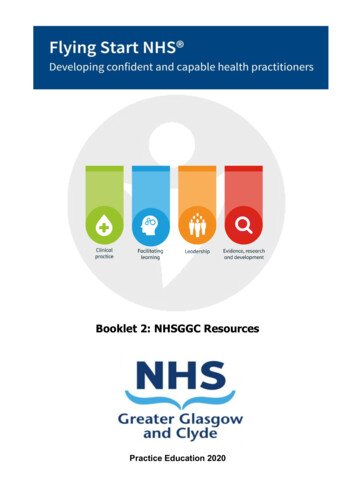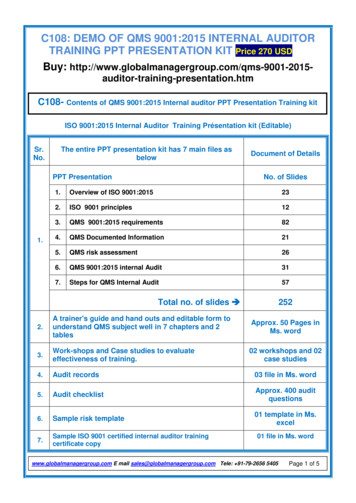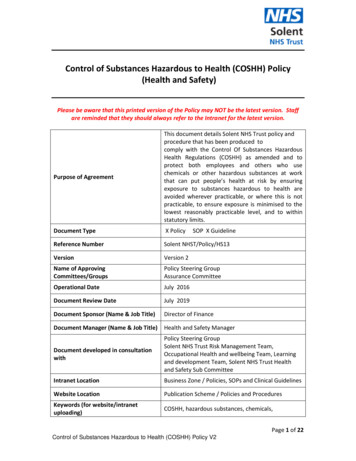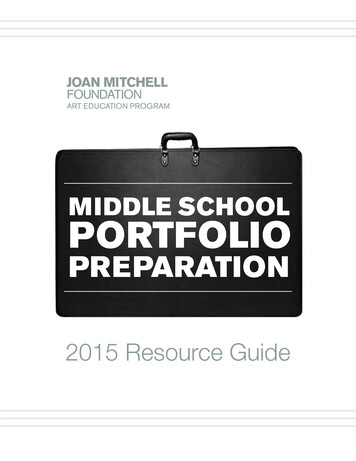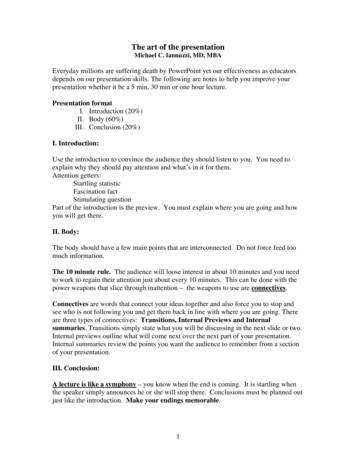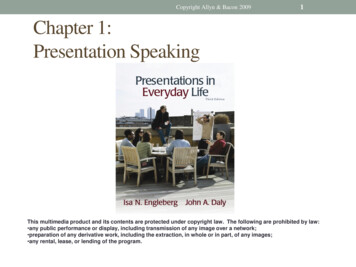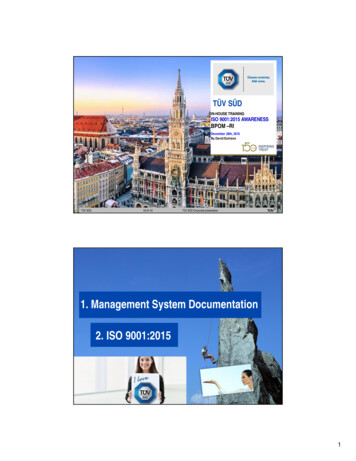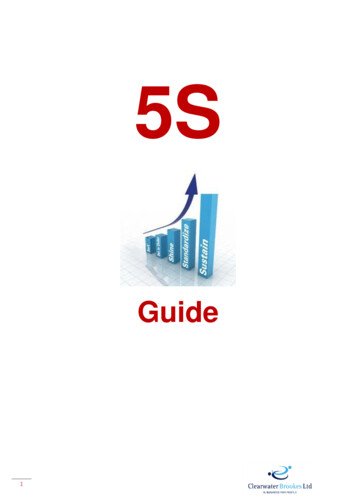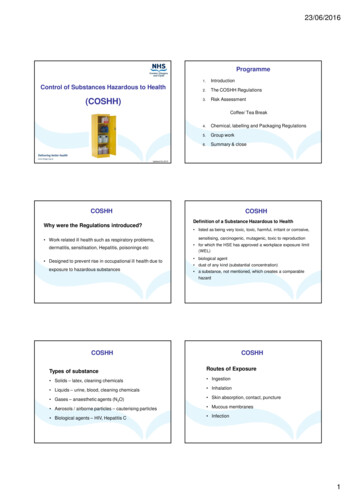
Transcription
23/06/2016ProgrammeControl of Substances Hazardous to Health(COSHH)1.Introduction2.The COSHH Regulations3.Risk AssessmentCoffee/ Tea Break4.Chemical, labelling and Packaging Regulations5.Group work6.Summary & closeUpdated Oct 2015COSHHWhy were the Regulations introduced?COSHHDefinition of a Substance Hazardous to Health listed as being very toxic, toxic, harmful, irritant or corrosive, Work related ill health such as respiratory problems,sensitising, carcinogenic, mutagenic, toxic to reproductiondermatitis, sensitisation, Hepatitis, poisonings etc for which the HSE has approved a workplace exposure limit(WEL) Designed to prevent rise in occupational ill health due toexposure to hazardous substances biological agent dust of any kind (substantial concentration) a substance, not mentioned, which creates a comparablehazardCOSHHTypes of substanceCOSHHRoutes of Exposure Solids – latex, cleaning chemicals Ingestion Liquids – urine, blood, cleaning chemicals Inhalation Gases – anaesthetic agents (N2O) Skin absorption, contact, puncture Aerosols / airborne particles – cauterising particles Mucous membranes Biological agents – HIV, Hepatitis C Infection1
23/06/2016COSHH RegulationsThe Regulations do not apply to:– radiation– high pressures– extreme temperatures– explosive or flammable properties– lead, asbestosNB. Other regulations apply to these risksCOSHH does not apply to patients’ exposure to medicinesor dental treatment, but covers staff exposure.COSHH RegulationsEmployers must Assess and undertake a suitable & sufficient riskassessment, and: Prevent or control exposure Maintain, examine and test control measures Monitor exposure (where required) Health surveillance (where appropriate) Provide information, instruction, training andsupervisionCOSHH RegulationsCOSHH RegulationsHierarchy of Control MeasuresOnly when these control measures cannot eliminate Eliminate the use of a harmful product or substance and use asafer one.exposure completely should Personal Protective Use a safer form of the product, eg paste rather than powder.Equipment (PPE) be issued Change the process to emit less of the substance. Enclose the process so that the product does not escape. Extract emissions of the substance near the source. Have as few workers in harm’s way as possible. Provide PPE such as gloves, coveralls and a respirator. PPEmust fit the wearer.Programme1.Introduction2.The COSHH Regulations3.Risk AssessmentCOSHH Risk AssessmentMust be ‘suitable and sufficient’,Undertaken by someone who is familiar with the task /environment and should include: assessment of risks to healthCoffee/ Tea Break focus on preventing exposure to substances steps that need to be taken to ensure adequate control of4.Chemical, labelling and Packaging Regulations5.Group work6.Summary & closeexposure identification of other necessary actions eg. Monitoring /training etc all assessments should be reviewed regularly – normallyannually or if there is a change in the process, an incident etc2
23/06/2016COSHH Risk AssessmentCOSHH Risk AssessmentFactors to consider in an assessment include: Type of substances to which employees are liable to be exposedAssessors guide: Where, and in what form, the substances are Locate previous assessment (if it exists) Effects of the substances on the body List Hazardous Substances involved May require an estimate of exposure (seek advice from Request current Safety Data Sheets from supplier orOccupational Hygienist) Consider storage, transport, handling and use in your area ofmanufacturer for all substances involved List associated activitieswork Spillage and disposal proceduresCOSHH - List of SubstancesChemical / Substance/ Product Name Classificationeg Harmful/ToxicWhere is it usedeg Location/OperationMaximumQuantity StoredCOSHH Risk AssessmentRisk Assessed?Yes/NoAssessors guide: Remove any substance that is not required If possible, substitute with less harmful substance e.g.effervescent bleach tablets for non effervescent Latex gloves for non latex Determine if a risk actually existsCOSHH Risk AssessmentRisk EvaluationDecide which level of risk exists –Low - Quantities or usage, too small to constitute aforeseeable risk to health.Medium - Risk is significant, but adequate control measuresare in place, further controls may be required to bring the leveldown to low risk.High / Very High - There is a risk to health and furthercontrol measures are required. Work should stop until thelevel is reduced, seek expert advice.Information, instruction & trainingThe employer must provide employees with information,instruction and training regarding the following: risk to health created by exposure precautions which should be taken results of monitoring results of health surveillance3
23/06/2016SAFETY DATA SHEETSSAFETY DATA SHEETSHeadings which should appear on safety data sheets Suppliers of hazardous chemicals must supply theircustomers with safety data sheets The safety data sheet is the starting point for the1. Identification of the substance / mixtureand of the company / undertaking2. Hazards identification3. Composition/information on ingredients4. First-aid measures5. Fire-fighting measures6. Accidental release measuresCOSHH assessment7. Handling and storage8. Exposure controls / personalprotection9. Physical and chemical properties10. Stability and reactivity11. Toxicological information12. Ecological information13. Disposal considerations14. Transport information15. Regulatory information16. Other informationSafety Data SheetInformation provided on safety data sheets includes:Health SurveillanceEarly detection of ill health associated with exposure tohazardous substances, can involve: Workplace Exposure Limits (WEL) Should not exceed WEL for a substance, except:– Examination by a doctor or trained nurseIf substance causes cancer, heritable genetic damage– Trained supervisors can check employees’ skin fordermatitis or ask questions about breathing difficultiesor asthma, reduce exposure to as low as is reasonably– Completion of a questionnairepracticableHealth / monitoring records must be kept for at least 40 yearsProgrammeTea Time1.Introduction2.The COSHH Regulations3.Risk AssessmentCoffee/ Tea Break4.Chemical, labelling and Packaging Regulations5.Group work6.Summary & close4
23/06/2016Classification, Labelling and Packaging(CLP), RegulationsCLP RegulationsSubstances and mixtures will be classified by: Requires classification and labelling of substances tobe consistent with CLP A Globally Harmonised System (GHS) of classificationand labelling of chemicals Labels will contain Sets general packaging standards to ensure the safesupply of hazardous substances and mixtures.CLP Pictograms-a pictogram-hazard statements-precautionary statementsCLP – Signal WordsThe CLP Regulations introduces two new signal wordsrequired for labelling:Danger - if the chemical has a more severe hazardWarning - if the chemical has a less severe hazardWhere several hazards requiring signal words are present,only the signal word for the most severe hazard will bedisplayed.CLP – Hazard StatementsCLP - Precautionary Statements Toxic to the aquatic life with long lasting effects May cause allergy or asthma symptoms or breathingdifficulties if inhaledA precautionary statement is a phrase that describes arecommended measure(s) to minimise or prevent adverseeffects resulting from exposure to a hazardous substance ormixture due to its use or disposal.Examples of precautionary statements include: Wear eye protection Do not eat, drink or smoke when using this product Avoid release to the environment In case of inadequate ventilation wear respiratoryprotectionIt replaces the ‘risk or R-phrase’ used in CHIPIt replaces the ‘safety or S-phrase’ used in CHIPA hazard statement is a phrase that describes the nature ofthe hazard in the substance or mixture. A hazard statementwill be determined by the application of the classificationcriteria.Examples of hazard statements include: Causes serious eye damage Toxic if swallowed5
23/06/2016ProgrammeLabelling Example1.Introduction2.The COSHH Regulations3.Risk AssessmentCoffee/ Tea BreakCOSHH Risk Assessment FormDepartment:-4.Chemical, labelling and Packaging Regulations5.Group work6.Summary & closeCOSHH Risk Assessment FormRef no:-Existing PrecautionsSubstance / ActivitySummarise current controls inplace Include any procedures for Storage,Is there a safe system of work for the activity? Yes / NoProduct /Hazard Classification(Corrosive, Harmful, Irritant,TradeToxic, Very Toxic)Name /Mixture etcChemicalNature (aerosol,Route of Entry /Exposuredust, fume, gas,liquid, powder, etc)(Absorption,Ingestion,Inhalation, Injection)Describe how they might fail toprevent adverse outcomes.Transport, Handling, Disposal andMaintenance as well as the general use ofthe substance.Emergency ProceduresIndividuals or groups exposedFirst AidDuration of exposureDoes the substance have a W.E.L.?Spillages*Yes / No*If Yes, contact Occupational Hygienist / Health & SafetyPractitionerIs a Safety Data Sheet Available?Yes / NoCOSHH Risk Assessment FormCOSHH Risk Assessment FormRisk MatrixHealth Surveillance/ Atmospheric MonitoringImpact / ConsequencesAlmost CertainMediumHighHighV HighV HighIs Health Surveillance or Atmospheric Monitoring of staffrequired?(If yes, contact the Occupational Health Service/ OccupationalHygienist)LikelyMediumMediumHighHighV HighNew & Expectant lihoodNegligibleMinorModerateMajorExtremeAre additional control measures required for new & expectantmothers?Yes / NoYes / NoIf yes, please specify:Very HighHighMediumLow6
23/06/2016COSHH Risk Assessment FormCOSHH Risk Assessment FormAction Plan (if risk level is High (Orange) or Very High (Red)Use this part of the form for risks that require action. Use it to communicate, with your LineManager or Risk Coordinator or others if required. If using a copy of this form to notifyothers, they should reply on the form and return to you. Check that you do receive replies.Describe the measures required to make the work safe. Include hardware – engineeringcontrols, and procedures. Say what you intend to change. If proposed actions are out withyour remit, identify them on the plan below but do not say who or by when; leave this to themanager with the authority to decide this and allocate the resources required.Action by Others Required - Complete as appropriate: (please tick or enterYES, name and date where appropriate)Report up management chain foractionReport to Estates for actionProposed actions to control the problemList the actions required. If action by others isrequired, you must send them a copyBy WhomStartdateActiondue dateContact advisers/specialistsAlert your staff to problem, newworking practice, interim solutions,etcCOSHH Quiz1.If you are supplied with a SDS is a COSHH assessment always required2.Can Latex gloves be classed as a hazardous substance3.Can staff choose whether or not to wear PPE when dealing withhazardous substances4.Are patients exposed to medicines covered by COSHH5.Is health surveillance required for all staff using hazardous substances6.How often should COSHH assessments be reviewed7.Can air monitoring be used to help assess the WEL is not exceeded8.What working conditions may cause contact dermatitisQuestions?Further information regarding COSHH or any aspect ofHealth and Safety can be found on our StaffNet pages7
CLP - Hazard Statements A hazard statement is a phrase that describes the nature of the hazard in the substance or mixture. A hazard statement will be determined by the application of the classification criteria. Examples of hazard statements include: Causes serious eye damage Toxic if swallowed
